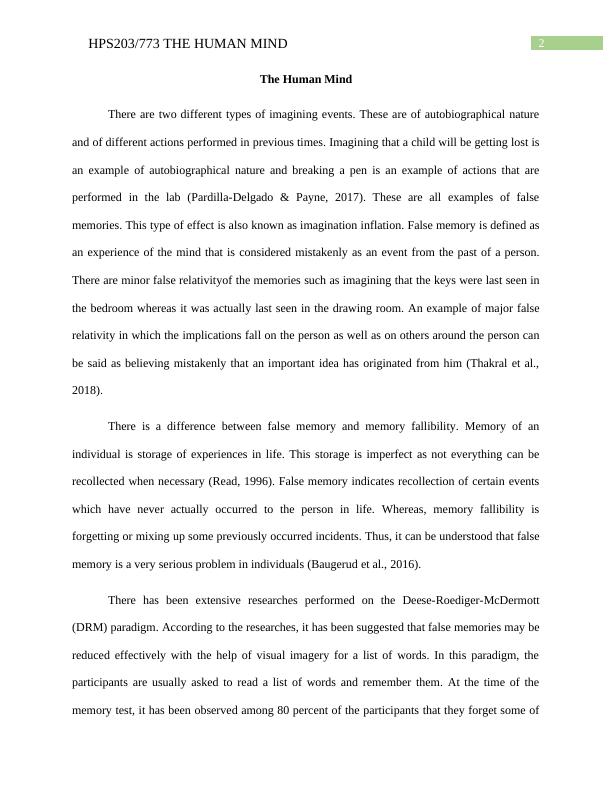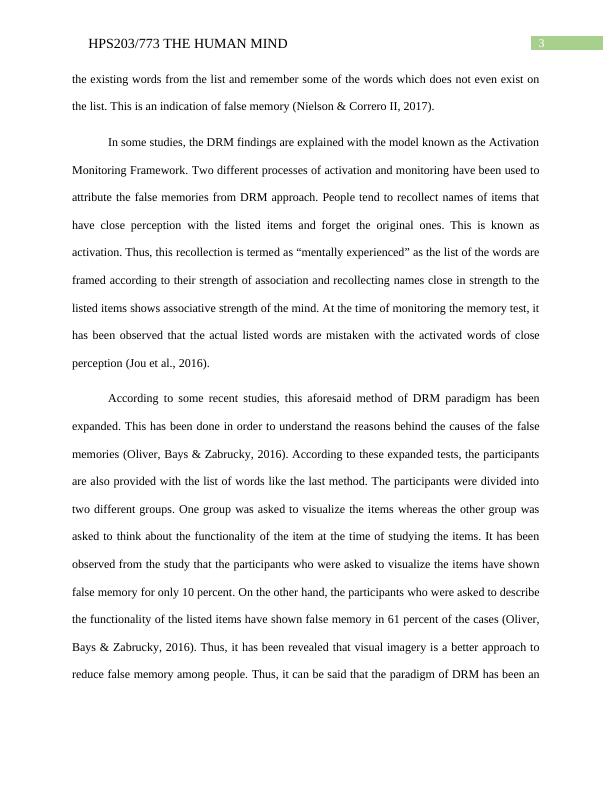HPS 203/773 - The Human Mind
11 Pages2864 Words53 Views
Added on 2021-06-15
HPS 203/773 - The Human Mind
Added on 2021-06-15
ShareRelated Documents
Running Head: HPS203/773 THE HUMAN MINDHPS203/773The Human MindName of the StudentStudent IDName of the UniversityWord Count

1HPS203/773 THE HUMAN MINDAbstractOne of the paradigms that are used to evaluate the rate of false memories in people is the Deese,Roediger and McDermott (DRM) task. Here, the subjects are listed with words that are relatedsemantically. They are provided with some time to process the words and then asked to recall thelisted words. Their recollection capability and type are monitored and in this way the rate of falsememory can be evaluated. The participants were distributed into three different groups of fastexposure, medium exposure and slow exposure. The difference in the rate of false memorybetween the three recollection groups have been tested using the analysis of variance (ANOVA)techniques. The results have shown that the fast exposure group have shown high rate of falsememory whereas no difference in the rates of false memory have been observed between themedium and the slow exposure groups.

2HPS203/773 THE HUMAN MINDThe Human MindThere are two different types of imagining events. These are of autobiographical natureand of different actions performed in previous times. Imagining that a child will be getting lost isan example of autobiographical nature and breaking a pen is an example of actions that areperformed in the lab (Pardilla-Delgado & Payne, 2017). These are all examples of falsememories. This type of effect is also known as imagination inflation. False memory is defined asan experience of the mind that is considered mistakenly as an event from the past of a person.There are minor false relativityof the memories such as imagining that the keys were last seen inthe bedroom whereas it was actually last seen in the drawing room. An example of major falserelativity in which the implications fall on the person as well as on others around the person canbe said as believing mistakenly that an important idea has originated from him (Thakral et al.,2018). There is a difference between false memory and memory fallibility. Memory of anindividual is storage of experiences in life. This storage is imperfect as not everything can berecollected when necessary (Read, 1996). False memory indicates recollection of certain eventswhich have never actually occurred to the person in life. Whereas, memory fallibility isforgetting or mixing up some previously occurred incidents. Thus, it can be understood that falsememory is a very serious problem in individuals (Baugerud et al., 2016). There has been extensive researches performed on the Deese-Roediger-McDermott(DRM) paradigm. According to the researches, it has been suggested that false memories may bereduced effectively with the help of visual imagery for a list of words. In this paradigm, theparticipants are usually asked to read a list of words and remember them. At the time of thememory test, it has been observed among 80 percent of the participants that they forget some of

3HPS203/773 THE HUMAN MINDthe existing words from the list and remember some of the words which does not even exist onthe list. This is an indication of false memory (Nielson & Correro II, 2017). In some studies, the DRM findings are explained with the model known as the ActivationMonitoring Framework. Two different processes of activation and monitoring have been used toattribute the false memories from DRM approach. People tend to recollect names of items thathave close perception with the listed items and forget the original ones. This is known asactivation. Thus, this recollection is termed as “mentally experienced” as the list of the words areframed according to their strength of association and recollecting names close in strength to thelisted items shows associative strength of the mind. At the time of monitoring the memory test, ithas been observed that the actual listed words are mistaken with the activated words of closeperception (Jou et al., 2016). According to some recent studies, this aforesaid method of DRM paradigm has beenexpanded. This has been done in order to understand the reasons behind the causes of the falsememories (Oliver, Bays & Zabrucky, 2016). According to these expanded tests, the participantsare also provided with the list of words like the last method. The participants were divided intotwo different groups. One group was asked to visualize the items whereas the other group wasasked to think about the functionality of the item at the time of studying the items. It has beenobserved from the study that the participants who were asked to visualize the items have shownfalse memory for only 10 percent. On the other hand, the participants who were asked to describethe functionality of the listed items have shown false memory in 61 percent of the cases (Oliver,Bays & Zabrucky, 2016). Thus, it has been revealed that visual imagery is a better approach toreduce false memory among people. Thus, it can be said that the paradigm of DRM has been an

End of preview
Want to access all the pages? Upload your documents or become a member.
Related Documents
Deese-Roediger-McDermott (DRM) Paradigm: A Study on False Memorylg...
|14
|3253
|146
Classic Studies & Cognitive Psychology Practical | Deskliblg...
|14
|3353
|309
Role of Imagery Instructions in Reducing DRM False Memorieslg...
|7
|1317
|343
